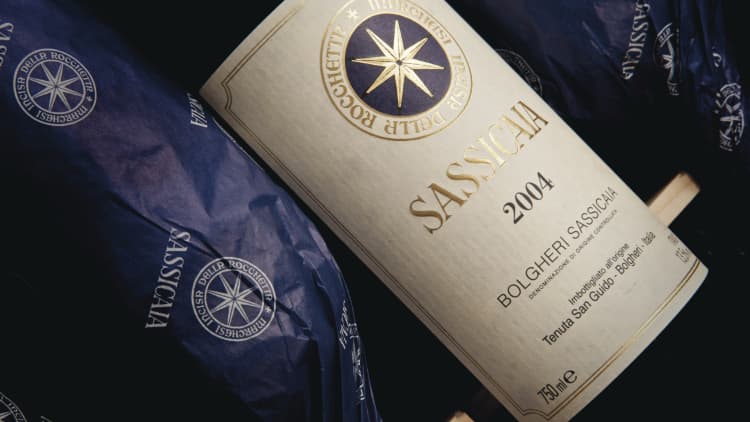
For the inexperienced, selecting a bottle of wine can be intimidating; but learn how to properly read a label, and even a novice has a shot at making a pick like a pro.
"Most people don't realize this, but there's more information on the outside of the bottle than on the inside," Joe Bastianich said.
The author of two books about Italian wine, Bastianich is a James Beard award-winning Wine and Spirits professional. A restaurateur with his foot in 30 restaurants, he's an investor on CNBC's "Restaurant Startup."
The sticker on bottles can vary greatly, especially from country to country. Yet, Bastianich gives a few tips about how to decode a label to select a good wine.
Variety or region: What's in a name?
A wine's name can say a lot about the type that's inside the bottle. Barolo is a red wine made from the nebbiolo grape variety. It's named after a locality in the Piedmont region of Italy where the grapes grow and the wine is made.
Unlike most American wine labels, a bottle of Barolo won't likely list the grape's name, which is also known as the variety.
Read More Doughnuts, Cronuts and ... Fonuts?
"In America, we name our wines after the varietal generally," he said. "So like, cabernet, sauvignon, merlot, sauvignon blanc. In Italy, it's principally geographically."
Appellation: The rules and regulations of wine
A wine's taste is all about place, so appellation can be the most important concept on a label, according to Bastianich. It refers to a legally defined geographic designation of origin; so it describes where the grapes that make up a wine grow.
Yet appellation's meaning varies by country; those who study wine can focus on it for semesters, so understanding it can be tricky. While not exhaustive, here's how it generally works.
In European countries, appellation is a regulatory classification system that protects both the geographical origin of a wine can determine the viticultural practices and vinification, or production process. Wines must meet requirements, some stricter than others, to be labeled a particular appellation. These standards are unlike the American system, which only regulates where the grapes grow.
Read More Hot trends in the restaurant world
The European Union maintains overarching laws and regulations, but specific countries also maintain their own longstanding systems. The most well known include France's AOC (Appellation d'Origine Contrôlée), Italy's DOC (Denominazione di Origine Controllata), and Spain's DO (Denominación de Origen), to name a few.
Tiers exist within many systems that require vintners to meet the most stringent controls before a wine can be labeled at the highest level, for example DOCG (Controlled and Guaranteed Designation of Origin) in Italy.
"There are different levels of quality, or a hierarchy in the wine world. So an appellation like a Grand Cru red Burgundy, or a first-growth Bordeaux, or a Napa Valley cabernet, or a Sonoma county pino noir, those are some of the most highly regarded and well-known appellations in the world," Bastianich said. "Stick to those, and you know you're selecting a good wine."
A wine's appellation in the U.S.
In the U.S., the term appellation is used loosely, according to Patsy McGaughy, the Communications Director for Napa Valley Vintners.
"In the U.S., it's all about place and where the grapes grow. It has nothing to do with production or process, so it's best to think about it more like a ZIP code," she said.
Determined by the federal government, an American Viticultural Area (AVA) is a special wine-growing region that shares similar geographical and cultural characteristics. Napa Valley is a good example, which became California's first AVA in 1981.
"We think the place is special because of its unique history, climate, geology and soil" she said.
Read More Taking on Starbucks, one cup at a time
To be labeled an AVA, the grape variety or the wine making process does not matter, only 85 percent of its grapes must originate from the area. But wines that are labeled by political boundaries require from 75 to 100 percent of their grapes to come from that particular county or state.
The importer: A reputation to trust
Listed on the back of a label, importers choose and select wines from foreign countries, some specializing in French, Italian, or German, etc. A good tip is to find an importer with a good reputation and shared similar taste.
"If you find an importer whose palate you agree with, and you consistently stick to their style, you can always refer to that importer in the wine store or in a restaurant, and get wines from them that you happen to like and trust," Bastianich said.
Vintage: Harvesting the grapes
Listed on labels as the year the grapes of a wine are harvested, vintages are important because wine is an agricultural product.
"Mother nature has a lot to do with the quality of the wine in the bottle. And it's really dependent on the growing season of that year," he said.
Read More One-dish restaurants: Just a fad?
So knowing which vintages are better than others and recognizing them on a label can help determine quality when selecting a wine.
Alcohol: How much in a bottle?
By law, every label of wine lists its alcohol percentage by volume. Wine is nothing more than fermented grape juice, and the sugar content of a grape directly corresponds to its potential alcohol. The more sugar concentration in a grape, the higher the potential alcohol in the wine.
"Some white wines might start out at 12 percent, some California and heartier wines might go up to 16-17 percent," Bastianich said. "There are wines that have 8 percent alcohol—we don't drink those, disgusting.
"Restaurant Startup" is on a quest to discover, invest in and launch America's next generation of epicurean superstars. Tuesdays at 10 pm ET/PT.


